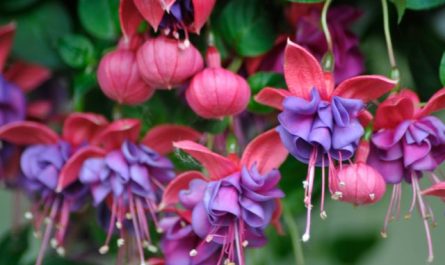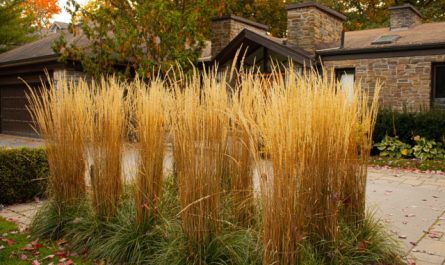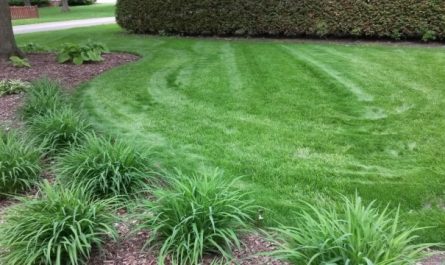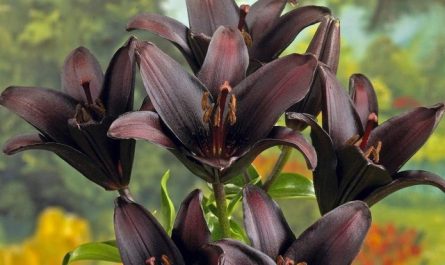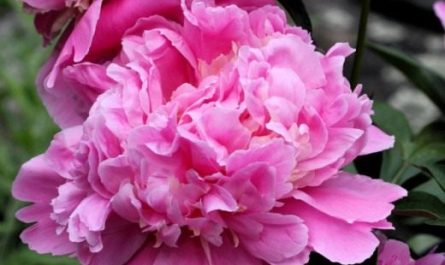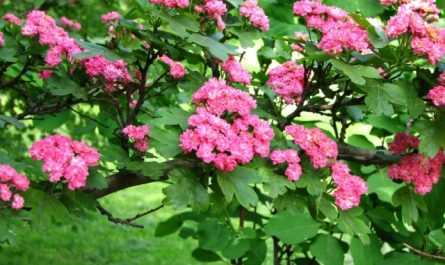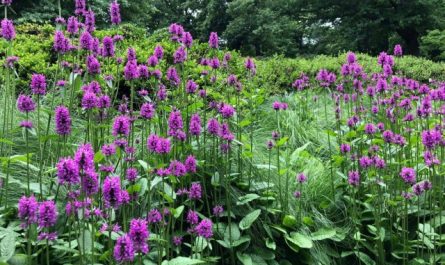Phloxes belong to the Polemonium family.
Their homeland (except for Siberian phlox) is the USA and Canada.
There are about 50 species in the genus Phlox, of which only one species is Drummond’s phlox is an annual plant, all other species are perennial.
The ancestor of most garden hybrid varieties is flox, paniculateIn the wild, it grows in clearings of damp forests, in lowlands located along river valleys in the states of Virginia, Pennsylvania, New York, Kansas, etc.
This is a tall bush of erect smooth stems, 60 to 180 cm high, ending in a large paniculate inflorescence.

The leaves are oval-lanceolate, green and dark green, smooth, up to 15 cm long, 1,5-4,0 cm wide, opposite, each pair of leaves is located crosswise in relation to each other.
The flowers are bisexual, on short peduncles, purple or clove-red (rarely white), about 2-2,5 cm in diameter, collected in paniculate inflorescences. The corolla of the flower has five petals, fused at the base into a long narrow tube, where there are five stamens and a pistil.
All varieties of phlox are grouped according to flowering time early, medium, medium-late and late.
Early in spring, almost immediately after the snow melts, above-ground shoots begin to grow from the rhizome.
During intensive growth of shoots, new roots are formed, old ones are lengthened and branched. At this time, the plant should be given abundant watering and fertilizing.
It blooms in July-September, very abundantly.

© Keith Pomakis
Flowers do not bloom at the same time. The inflorescence reaches its full decorative effect only after 8-10 days, when a significant part of the flowers have bloomed. A blooming flower remains on the inflorescence for 7-10 days, then its corolla falls off, and a nearby bud blooms instead, due to which the decorative effect of the inflorescence is preserved for a long time. In addition to the main panicle, inflorescences are often formed from the axils of the leaves and the upper part of the stem, they bloom later.
The flowering period for different varieties ranges from three to four to five to six weeks.
After flowering, the plant enters the stage of accumulating reserves of nutrients in the rhizomes and roots for the vegetation of the next year. At this point, growth buds begin to form on the rhizomes and lignified shoots near the soil surface, from which shoots will develop next year.
After the seeds ripen, the inflorescences, leaves and stems begin to dry out. By winter, the entire above-ground part dies off, life processes slow down significantly and the plant goes into a dormant state.

© Bff
Site selection and soil preparation
For successful cultivation of phloxes, open, level areas with a slight slope, sufficiently moistened, protected from winds are necessary. Glades in gardens and parks, illuminated paths and alleys are the best places for planting phloxes.
Phloxes grow well, bloom abundantly and for a long time on sandy loam, medium loam, moist and loose soils, well fertilized (at the rate of 800-1000 kg per 1 ha) with mineral fertilizers. The acidity of the soil should be close to neutral, but phloxes tolerate slightly acidified soils quite well.
Organic fertilizers (semi-decomposed manure 1-1,5 buckets, bone meal 120 g and ash 180 g per 1 sq. m) should be applied together with mineral fertilizers during autumn plowing. The plowing depth is 20-25 cm. The bulk of phlox roots are located at a depth of 3 to 15 cm, so deep application of organic fertilizers is impractical and even harmful.
On heavy clay soils, in the fall, during plowing, in addition to organic and mineral fertilizers, sand and lime are also added at a rate of 250-300 kg/ha, and on sandy soils, clay.
In the spring, as soon as the soil is ready for cultivation, the plots are plowed to a depth of 20-25 cm and additionally semi-decomposed manure or other organic fertilizers are added at a rate of one to one and a half buckets per 1 sq. m on loamy soils. On acidic podzolic soils, the dose of organic fertilizers is increased and lime (200-300 g) and bone meal (100-150 g per 1 sq. m) are added at the same time.
In spring, add mineral fertilizers (per 1 sq. m): 30 g ammonium nitrate, 50-60 g superphosphate, 30 g potassium salt.

Planting plants
In autumn, parts of the bush with two or three stems and a well-developed root system are used as planting material. For spring planting, the bush is divided so that the seedling has three or four buds and a good root system.
If seedlings obtained from rooted cuttings are used as planting material, then those that formed in the second year after rooting and have two or three shoots during autumn planting, and three or four buds during spring planting are allowed for planting. The distances between plants during planting are selected taking into account the height of the bush and the duration of the phlox stay in one place: 35-45 X 30-40 cm, 50-60 X 40-50 cm.
Perennial phlox can be planted in early spring, as soon as the soil has thawed and is suitable for cultivation and planting, or in autumn, in the first half of August, so that the seedlings have time to take root before the onset of frost.

© Ebyabe
Plant Care
In early spring, the plants (if they were covered for the winter with peat, humus, leaves, etc.) are freed from shelters. Further care consists of regular loosening of the row spacing, fertilizing and weeding.
The first feeding with a solution of mullein, liquid manure, bird droppings or faeces is carried out in a dilution of 1:15 during the period of mass growth of stems. Mineral fertilizers can also be used at the rate of 20-30 g of ammonium nitrate, 15-20 g of superphosphate and potassium salt per 10 liters of water.
The second feeding is carried out at the beginning of budding. It is better to apply it in liquid form, adding phosphorus and potassium fertilizer to the solution of liquid manure, mullein or feces at the rate of 20-25 g of each per 10 l of solution.
The third feeding is given at the beginning of flowering: 15-20 g of superphosphate, 10 g of ammonium nitrate, 10-15 g of potassium salt or 30-40 g of ash per 10 liters of water.
At the end of flowering (August), phloxes are fed with phosphorus and potassium (15-20 g superphosphate, 25 g potassium chloride per 10 l of water). This feeding promotes the accumulation of nutrients and hardening of plants.
When the air temperature drops to -10 -20® in areas with poor snow cover, plants are covered with peat, humus, and leaves.

© Epibase
Reproduction
Phloxes are propagated division of bushes, stem, stem with heel or leaf cuttings, axillary cuttings with heel.
Propagation of phlox by dividing the bushes is the simplest and most common method. The bush is dug up and divided into parts with a shovel or knife so that each planting unit has three to four buds (in spring) and two to three shoots (in autumn) with a well-branched root system.
In production conditions, the method of reproduction is effective stem cuttings.
Before budding, the stem is cut crosswise into cuttings so that each of them has at least two nodes. The lower cut is made in the lower part of the node under the paired leaves, in the upper part of the cutting, the node with the paired leaves is left. The upper cut is made 1-2 cm above the node.
2/3 of the leaf blade is cut off from the lower leaves and the cutting is immersed in a layer of wet sand in a breeding bed or greenhouse. Timely cuttings make it possible to obtain rooted seedlings for planting in the spring of the following year.

© Bff
Stem cuttings with a heel. In early spring, at the beginning of the growth of plants, shoots (4-6 cm long) with a heel are broken off from the mother bush, separating them directly from the rhizome; these cuttings take root most quickly and by autumn produce a normally developed flowering plant.
Leaf cuttings. For propagation of valuable varieties, represented by a limited amount of source material, leaf cuttings can be used. For cuttings, a stem is taken before budding (woody stems that had inflorescences can also be used, but the yield of rooted cuttings will be lower).
The leaves are cut with a part of the stem, up to 2-3 mm thick and up to 1 cm long. The lower part of the leaf with the heel is immersed in an inclined position in the wet sand of a nursery or breeding box and covered with glass. Rooted cuttings give small plants that develop well when planted in the ground in spring.
Axillary cuttings with a heel. The top of the stems is pinched off before budding. Stepchildren are formed in the leaf axils. When they reach a length of 4-6 cm, they are broken off with part of the main stem. Such cuttings root well.

© Epibase

